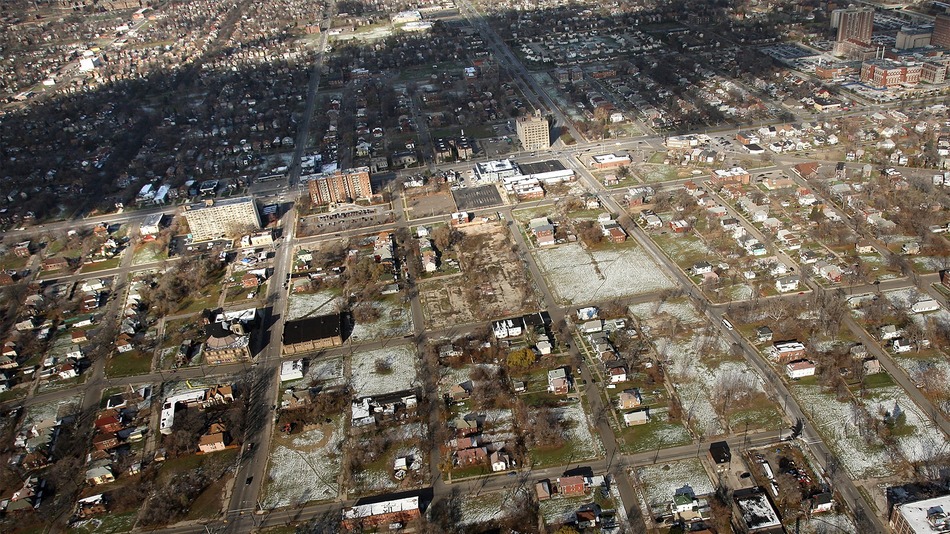(Source: sneurgaonkar/Flickr/Creative Commons)
In 1995, we encountered a group of economic advisors to Governor John Engler of Michigan, intent on cutting property taxes. We reminded them of California’s 1979 Proposition 13. After Prop. 13 rolled back and froze property taxes, sales taxes reached crushing levels, budget crises became routine, local services collapsed, and public schools fell from the best in the nation to among the worst. But Engler was determined.
| This article was originally published in Inequality.org and appears here by way of special arrangement. |
From 1890-1930, Detroit’s population boomed from 205,000 to 1,569,000, the fastest growth of any US city. The auto industry did it, but why Detroit? Detroit had produced horse-drawn carriages from hardwood lumber, but so had other places. It was not low wages; Detroit paid better than most—that’s why so many people rushed in. It was not business-dominated politics; Michigan was a Progressive, Bull Moose Teddy Roosevelt state. It was not low taxes on wealthy “job-creators”; Michigan relied on high state and local property taxes. As most people recognized in those days, (and as we have documented here and here), property taxes are wealth taxes, dramatically more progressive than income taxes.
Detroit Mayor Hazen Pingree, 1889-1897, was an early Georgist Progressive. He supported the idea of American economist and reformer Henry George (1839-1897) that all taxes should be shifted onto land and other natural resources. Today, Nobel-Prize-winner Joseph Stiglitz advocates this as the “Henry George principle.”
Applied to cities, it means raising property tax rates on land and lowering them on buildings. In cities, poor renters own no land, heavily-mortgaged middle classes own very little. So shifting taxes to land turns property taxes into wealth taxes on steroids. Better yet, taxing land discourages rich speculators from holding valuable property out of use.
| In old Detroit, property tax rates of 2.5 percent of market value were normal; there were no sales taxes, business taxes, or income taxes. |
The crash of 1893 hit Detroit soon after Pingree’s election. The city was riddled with vacant lots held by land speculators; Pingree arranged for the unemployed to plant vegetables. “Pingree’s Potato Patches” inspired other cities to follow. Meanwhile, he had campaigned for “higher taxes on the vast landed estates of the city”; when big industries threatened to leave town, he responded by raising just the land assessments. This won the support of small business.
The Georgist Progressive movement supported cheap mass transit on trolley cars. With fixed costs funded by property taxes, fares stayed low. Property taxes also paid for public education, public health, public parks, water, sanitation, welfare—all the public services that make a big city livable, and its small industries viable. Property tax rates of 2.5 percent of market value were normal; there were no sales taxes, business taxes, or income taxes. Detroit’s private sector was a big collection of small machine shops, little businesses and services. That’s what attracted Henry Ford, the Dodge brothers and other young tinkerers to Detroit. In one of history’s ironies, trolley cars nursed the auto industry that later rose up to slay them.
In 1897, Pingree became governor. He centralized the assessment of property taxes, and had the State Board of Tax Commissioners revalue all property. They found so much untaxed land, especially railroad holdings, that they actually lowered tax rates even as they raised more taxes.
During the “Dirty Thirties,” Detroit grew while many cities shrank. Walter Reuther’s UAW pioneered the sit-down strike at the GM plant in Flint. Former Detroit Mayor and now Governor Frank Murphy negotiated a settlement that legitimized the UAW, using the new national Wagner Act. It was “the strike heard round the world.” UAW membership exploded from 30,000 to 500,000.
After Pearl Harbor, FDR naturally turned to Detroit to convert its assembly lines to war production. This was the age of Rosie the Riveter, and Rosie loved Detroit. From 1930 to 1950, Detroit’s population grew 18 percent, to 1,850,000.
Yet after 1950, Detroit began to shrink, the first break in its sensational upward trajectory. What happened? Some blamed the end of the war, but America was pouring billions into the Interstate Highway System. The world wanted American cars and trucks. The causes of decline must have been internal.
| Shifting taxes to land turns property taxes into wealth taxes on steroids. |
Governor G. Mennen “Soapy” Williams, 1949-1960, introduced the Business Activities Tax (BAT), a kind of sales tax. The BAT was replaced by a corporate income tax in 1967 and by the Single Business Tax (SBT) in 1975. The SBT allowed the deduction of inputs—including real estate purchases!—but not labor. Easy for big corporations to evade, the SBT fitted concrete boots on small unincorporated businesses.
Governor George Romney, 1962-1968, introduced a personal income tax to provide “property tax relief,” a new catchword. Meantime in Michigan and nationwide, the property tax itself was degenerating; effective rates were falling, especially on land. Its Georgist heritage forgotten, Detroit was valuing land at next to nil, using assessments dating from the Great Depression. In 1967, a police raid on an unlicensed late-night drinking club in a black neighborhood triggered Detroit’s notorious 12th Street riots, which destroyed over 2,000 buildings. Detroit never recovered.
While Detroit hollowed out, its suburb Southfield boomed. From 1950-1970, it grew from 19,000 to 69,000 people. It had a Georgist Mayor, James Clarkson, who aggressively raised land assessments and lowered building assessments. Southfield’s tax base actually rose by 20 percent per year under Clarkson, funding good utilities and public services. The lesson went unnoticed.
In 1995, despite our warnings to his staff, Governor John Engler took Michigan’s public schools off local property taxes and onto a state sales tax. That sealed Detroit’s fate. Out-migration of people and industry accelerated into the 2008 crash. Detroit’s current population of some 700,000 is the lowest since 1914. In another of history’s ironies, Detroiters today grow food in vacant lots—“Pingree’s Potato Patches” again, 105 years later. Bankruptcy was inevitable.
And yet Detroit’s property tax base remains. Though diminished and badly-assessed, it could still fund a renewal if Michigan reads its history and finds the political will.
Polly Cleveland is Adjunct Professor of Environmental Economics at Columbia University School of International and Public Affairs. Mason Gaffney is Professor of Economics at the University of California at Riverside.






0 Comments